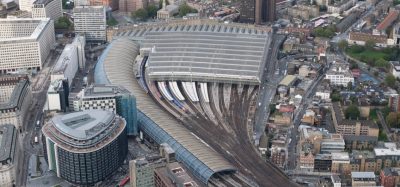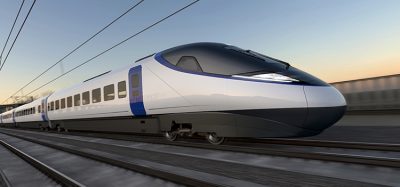High levels of mechanisation in Swiss track maintenance
Posted: 1 August 2008 | | No comments yet
SBB is minimising the amount of time track is tied up with maintenance, by automating inspection systems and adopting standard components that can be installed rapidly. Global Railway Review’s Technical Editor, James Abbott, talks to Daniel Wyder, SBB’s Head of Asset Management for Track.
SBB is minimising the amount of time track is tied up with maintenance, by automating inspection systems and adopting standard components that can be installed rapidly. Global Railway Review’s Technical Editor, James Abbott, talks to Daniel Wyder, SBB’s Head of Asset Management for Track.
SBB is minimising the amount of time track is tied up with maintenance, by automating inspection systems and adopting standard components that can be installed rapidly. Global Railway Review’s Technical Editor, James Abbott, talks to Daniel Wyder, SBB’s Head of Asset Management for Track.
Switzerland has some of the most intensely used railway lines in the world. During the day, a domestic passenger service organised on a regular interval system runs, while at night there are frequent trans-Alpine freight trains in transit from Germany to Italy running over the north-south main lines. The intensive traffic results in heavy annual tonnages: Switzerland overtook Japan in 2000 in having the world’s highest density of railway operations.
With such heavy usage, efficient maintenance to keep the permanent way in good condition is crucial. But the intensive service means that the time available for inspectors on the track is limited.
New line
Earlier this decade, SBB (Swiss Federal Railways) built a new 200km/h line from Rothrist to Mattstetten to cut journey times for passenger trains between Berne and Zürich. Opened in December 2004, this route also accommodates freight trains and carries some heavy tonnages.
To cut down time for inspections on the new line and elsewhere on the network, SBB invested in a diagnostic car to analyse track quality. Built by MerMec in Italy, this vehicle was first used for checking track geometry; the number of applications has expanded as experience has been gained with the new vehicle. Now fully bedded in, the vehicle can check both track and overhead line at speeds up to 120km/h and replaces SBB’s old track geometry recording vehicle and overhead line inspection vehicle.
Sophisticated systems
The machine is equipped with sophisticated systems, undertaking both measurement and inspection; the full list of functions is shown in the panel.
As an example of the measurement function, three cameras store an image every 7mm of the track profile, illuminated with lasers. On-board systems evaluate the quality of the tightening of track fastenings, the position of axle counters and of Signum-, ZUB- and European Train Control System antennae in respect to the track, and the presence of vegetation in the ballast.
As an example of the inspection function, three cameras take a black and white picture of the track every 1mm, allowing evaluation of:
- The presence and position of rail fastenings
- Defects on the rail surface
- Cracks in concrete and steel sleepers
- Detection of mud in the ballast
- Detection of ‘dancing’ sleepers
- Position of the rail anchors
A similar inspection system for overhead contact line is under development.
Frequent visits
The diagnostic vehicle checks the track on the new line once every 14 days, replacing conventional foot patrols. It also visits the new Lötschberg base tunnel on the same frequency.
The fortnightly visits of the diagnostic vehicle have replaced foot patrols for inspection of plain line on the Rothrist-Mattstetten route, as well as in the Lötschberg base tunnel.
There are some high-speed switches on the line – supplied by track engineering company VAE. These switches feature rollers to support the blade ends and allow trains to switch tracks at the full line speed of 200km/h. These switches require visual inspection by foot patrols every two months.
In total, the new line is shut for inspection and maintenance purposes for just 20 six-hour night possessions each year. This maximises availability for revenue-earning traffic.
SBB has found that shutting the line completely for 20 nights a year is the most economic method of maintenance on such highly used tracks, as it allows the work teams unfettered access to the track without any need for look-outs.
The methods adopted by SBB for inspection of the new high velocity line have made it a very safe workplace for track workers. The diagnostic vehicle eliminates the need for people walking alongside the track for plain line inspection. When maintenance work is undertaken or switches are inspected on the new line, they are doing so under conditions of total possession, eliminating any possibility of getting hit by a passing train.
Maintenance plan
While the frequent visits of the diagnostic vehicle have eliminated any need for foot patrols for plain line inspection on the new line, the MerMec vehicle is also used on the rest of Switzerland’s track system. All the country’s main lines are visited twice a year, building up a library of information on track and overhead contact line condition. “This defines our large-scale maintenance programme for next year, with the work patterns for the tamping and rail grinding machines”, explains Daniel Wyder, SBB’s Head of Asset Management for Track.
Conventional foot patrols undertake visual inspections of the main lines once every 14 days. Information from these inspections determines the day-to-day maintenance schedule.
Mr. Wyder expects that further automation of inspection will be introduced as the method is perfected. “We are finding lots of ‘failures’ on the track with the diagnostic vehicle at present, and while some of these are important, others are negligable, and the machine is having to learn to distinguish between the two.”
SBB has found that the operating costs of the diagnostic vehicle do not differ much from foot patrols, as there is a need for three people on the train and skilled back-up IT staff to translate the data collected into useable information. The real advantage comes with the number of kilometres the diagnostic train is able to cover and the contribution it makes to keeping SBB’s track in high quality condition.
Asset register
SBB is one of the most advanced railways in Europe when it comes to knowing about the condition of the company’s own assets. The railway’s rigorous inspection system is complemented by a comprehensive asset register known as the Database of fixed Assets (DfA). This is the largest Geographic Information System (GIS) in Switzerland.
The information in the register was collated in a SFr110million programme in the 1990s, an investment which is paying dividends. “The register was expensive to set up, but it is now a very powerful tool”, says Mr. Wyder. “We estimate the annual costs of the DfA at SFr14.4million, compared to benefits of SFr22.6million.”
All the railway’s assets are in the computer register, which is connected to the official database of the Swiss government and ties in with country’s ordnance survey. “The track and the overhead line are all complete and in the register”, explains Mr. Wyder. “We just have a little more work to do on inclusion of signalling assets such as fibre optic cables”.
Tamping machines on the Swiss network have an interface with the data base, so before work begins a file is exported to the tamping machine with all the relevant data on the stretch of line about to be treated. “This way the machine knows exactly where the track has to be, and this gives us very high quality trackwork”, says the Head of Asset Management.
Mechanised trackwork
Computerised studies undertaken by SBB have shown that high quality track is actually the most economic track: attempting to save money on the initial installation, or by taking ‘maintenance holidays’, are false economies that end up costing more money in the long run. “We have found that very high initial quality of track is essential, and then we aim to keep it that way with regular tamping and further maintenance measures”, says Mr. Wyder.
Switches and crossings are an interesting case study. To ensure a consistent level of quality and minimise time on the track, SBB has invested in a switch factory at Olten. Instead of the conventional method of laboriously assembling a replacement switch on the trackside, and then moving it into place component-by-component during a lengthy possession, factory methods are used.
Computer aided design techniques produce drawings of the replacement switch required, which is then fully assembled in SBB’s Olten factory. The logistics of getting the finished switch panel to the worksite are carefully planned: SBB has set up the Euroswitch logistics company in conjunction with Sersa, a Swiss track maintenance contractor.
Euroswitch transports new switch panels to the worksite on specially-built rail wagons, which tip the switch on its side in order to accommodate it in the loading gauge. Once at the worksite, the old switch can be removed and the new one inserted by a crane in an eight-hour possession.
Global Railway Review Autumn/ Winter Issue 2025
Welcome to 2025’s Autumn/ Winter issue of Global Railway Review!
The dynamism of our sector has never been more apparent, driven by technological leaps, evolving societal demands, and an urgent global imperative for sustainable solutions.
>>> Read the issue in full now! <<<







